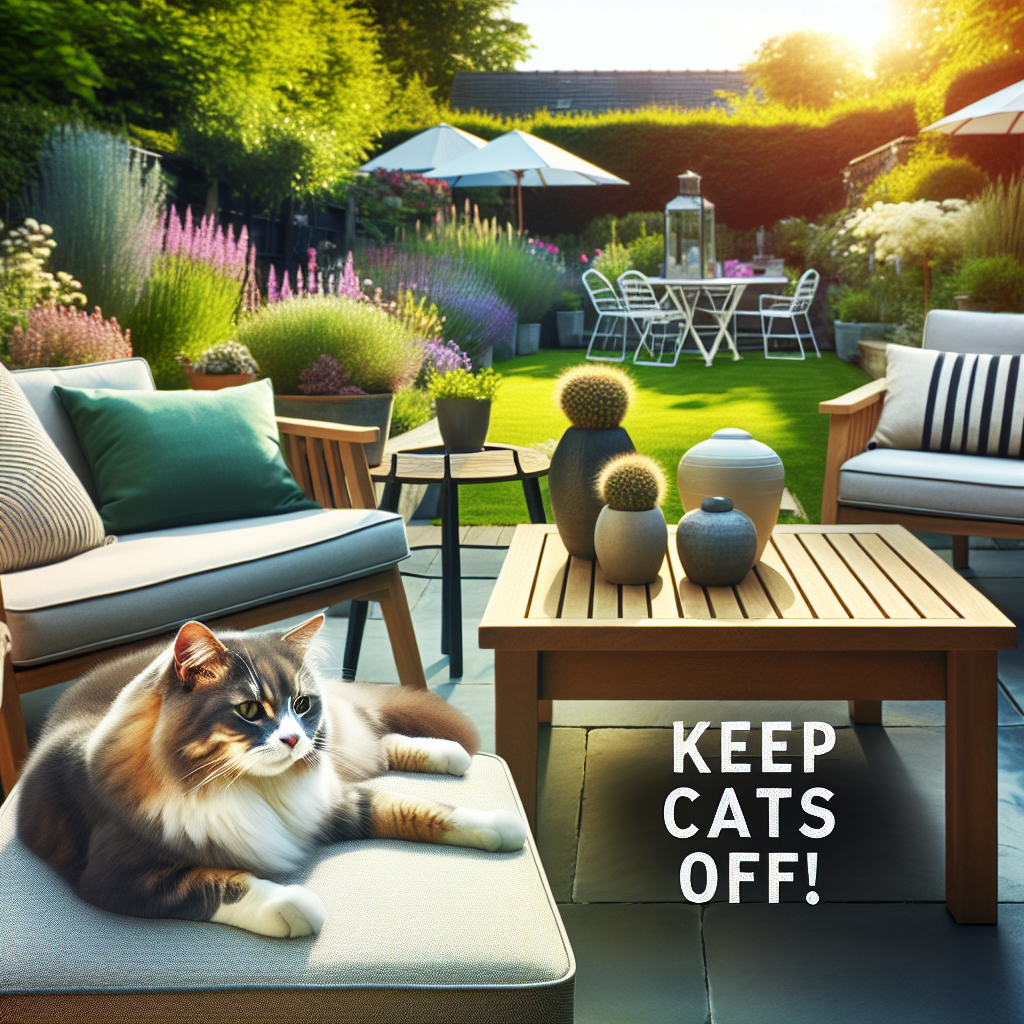Are you tired of finding your beloved outdoor furniture covered in cat fur or scratched by your furry friends? You’re not alone. Many pet owners and homeowners need help keeping their cats off outdoor furniture. Cats love to lounge, scratch, and even mark their territory on comfortable surfaces, making it a common issue for many. In this guide, we’ll explore why cats are drawn to outdoor furniture, the damage they can cause, and some effective strategies to keep them away. Let’s get started!
Table of Contents
Understanding Why Cats Love Outdoor Furniture
The Appeal of Elevated Surfaces
Cats are naturally inclined to seek out elevated surfaces. These spots allow them to survey their surroundings and feel secure. Outdoor furniture, like tables and chairs, provides the perfect perch for your feline friends.
Territory Marking
Cats are all about claiming their space. They’ve got this habit of scratching and rubbing their scent on things to say, “this is mine.” So, your outdoor furniture? It’s a prime spot for them to mark their new territory.
Comfort and Warmth
Outdoor furniture is comfortable and often sits in sunny spots, making it an ideal cat lounging area. The cushions and fabrics provide a soft and warm surface for them to relax.

The Damaging Effects of Cats on Outdoor Furniture
Scratches and Claw Marks
Cats love to keep their claws sharp and show who’s boss by scratching surfaces. Sadly, this means your outdoor furniture might end up with unwanted scratches and claw marks, making it look less appealing and not last as long.
Hygiene Concerns
Cats may sometimes urinate on outdoor furniture to mark their territory. This can lead to hygiene issues and unpleasant odors. If not cleaned properly, it can cause permanent damage to your furniture. Regular cleaning and pet-safe cleaners are essential to maintain a clean and welcoming outdoor space for you and your guests.
Potential for Furniture Deterioration
Continuous scratching and exposure to cat urine can weaken the fabric and structure of your outdoor furniture, causing it to deteriorate more quickly. This means you’ll have to replace your furniture more often than you’d like.
Effective Solutions to Keep Cats Off Outdoor Furniture
Implementing Cat-Friendly Alternatives
Provide Cat-Friendly Furniture
Offering outdoor furniture is one way to redirect your cat’s attention. Cat trees, scratching posts, and outdoor cat condos are great options that satisfy their need to climb, scratch, and lounge.
Create a Cat Play Area
Designate a specific area in your yard or patio for your cats to play and relax. Include toys, scratching surfaces, and cozy spots to make it an appealing alternative to your outdoor furniture.
Use Catnip and Treats
Want to keep your cats off the furniture? Try sprinkling some catnip or tossing a few treats into their play area. It’s a simple trick that works like a charm—positive vibes only!

Home Remedies to Deter Cats
Citrus Spray for Cats
Cats dislike the smell of citrus. Create a homemade citrus spray by mixing water with lemon, lime, or orange juice. Spray this mixture on outdoor furniture to deter your cats from lounging or scratching.
Vinegar Solution
Did you know? Cats aren’t vacant vinegar. Just whip up a mix of water and vinegar, equal parts, in a spray bottle and give your furniture a quick spray. This easy trick is a game-changer for keeping your furry pals off the sofa.
Use Pine Cones or Coffee Grounds
Scatter pine cones or coffee grounds around your outdoor furniture. Both materials have textures and smells that cats dislike, making them an effective deterrent.
Technology to Keep Cats Away
Do you have a cat that loves lounging on your outdoor furniture too much? Try motion-activated sprinklers! They spot movement, and whoosh – ouIt’smes a harmless burst of water. It’s a gentle but effective way to make your cat think twice before turning your favorite chair into their afternoon nap spot.
Ultrasonic Cat Repellents
Ultrasonic cat repellents are pretty cool gadgets. They let out high-pitched souncan’tat cats find annoying, but we can’t hear a thing. Just pop them near your outdoor furniture, and voila, your furry friends will steer clear without any harm done.
Electronic Cat Deterrents
Various electronic cat deterrents on the market use different methods, such as vibrations or sounds, to deter cats. These devices can be placed on or near your furniture to keep cats away.

Training and Behavior Modification
Positive Reinforcement Techniques
Training your cats using positive reinforcement can be an effective way to modify their behavior. Reward them with treats, praise, or playtime when they use their designated play area instead of your furniture.
Consistency is Key
Consistency is crucial when training your cats. Ensure all family members are on board with the training plan and consistently reward positive behavior while discouraging negative behavior.
Avoid Punishment
Don’t use punishment to keep your cats off the outdoor furniture, okay? It can freak them out and make things worse. They might end up hating the furniture and acting out more. What works better? Positivities and redirection. Trust me, it’s a game-changer.

Maintenance Tips for Outdoor Furniture
Regular Cleaning
Clean your outdoor furniture regularly to eliminate cat smells. This will keep your cats from returning to their favorite spot. And yeah, always use pet-safe cleaners to keep your furniture looking great.
Use Furniture Covers
Get sturdy furniture covers to protect your outdoor pieces from They’rees, dirt, and other damage. They’re easy to take off and clean, giving you extra protection.
Apply Cat Repellent Sprays
Use commercial cat repellent sprays specifically designed to deter cats from your furniture. These sprays are usually safe for pets and humans and can solve your problem conveniently.
Real Stories and Testimonials
Success Stories from Cat Owners
Many cat owners have successfully used these strategies to keep their cats off outdoor furniture. For example, Jane from New York shared how motion-activated sprinklers transformed her patio into a cat-free zone, allowing her to enjoy her outdoor space without worry and experience a sense of relief and peace of mind.
Tips from the Community
Why not dive into some online forums or social media groups where cat lovers share stories and tips about keeping those furry bits off your outdoor furniture? It’s great to connect and learn from others’ experiences. Plus, you may stumble upon some pretty neat ideas, too!
Expert Advice
Consult with veterinarians or animal behaviorists for expert advice on managing your cat’s behavior. They can offer personalized recommendations and solutions tailored to your specific situation, providing you with reassurance and confidence in your approach.
Conclusion
Dealing with cats on outdoor furniture can be a headache. But don’t worry; you can keep your feline buddies and furniture happy with the proper treats. It’s about understanding your cat’s behavior, finding excellent cat-friendly options, and trying modern gadgets to keep that bay. Imagine the sense of empowerment when you successfully manage your cat’s behavior. Do you have tips or stories of your own? We’d love to hear all about it!
Are you ready to transform your outdoor space? Sign up for our newsletter to receive a downloadable guide with all these tips and more, and join our community of pet-loving homeowners!
Frequently Asked Questions (FAQ)
What strategies can I employ to deter my cat from leaping onto the outdoor furniture?
You can use a combination of deterrents and positive reinforcement to prevent your cat from jumping on outdoor furniture. Place motion-activated sprinklers, ultrasonic repellents, or electronic cat deterrents near your furniture to discourage your cat. Additionally, provide a designated play area with cat-friendly furniture and use treats or catnip to encourage your cat to use it.
Can I use safe, non-toxic sprays on my furniture to keep cats away?
Totally! You can easily use non-toxic sprays at home that will send your cats running the other way. Mix some water with a splash of lemon, lime, or orange juice to whip up a citrus spray. You’re the smell of citrus. Or, if you’re feeling adventurous, try mixing water and vinegar in equal parts for a vinegar solution. Trust me, it works wonders!
How often should I clean my outdoor furniture to keep cats away?
It is advisable to clean your outdoor furniture regularly, ideally once a week, to remove any traces of cat scent. This discourages your cat from returning to the same spot. Use pet-safe cleaning solutions to ensure the longevity and safety of your furniture. What toys should I include in my cat’s cat’s sgnated play area?
Ensure your cat’s play area is super fun by loading it with toys that spark their hunting instincts—picture cat trees, scratching posts, awesome interactive toys, and cozy spots for lounging. And why not throw in someIt’llip toys for extra excitement? It’ll make the space more appealing.
Is it safe to use ultrasonic cat repellents around my pet? Yeah, they’re safe to use around pets. They send out high-frequency sounds that cats find annoying to us humans, and other animals can’t hear them. Still, chatting with your vet before using any new gadgets around your friend is a good idea.
Can training modify my cat’s behavior?
Training can change your cat’s behavior. Use positive reinforcement, like treating them to some goodies, giving them a good scratch, or playing with them when you hang out in their area. You’ll see the behaviors you’re for. Remember, staying consistent and patient is the secret sauce to making it work.
What should I do if my cat still insists on using the furniture despite all my efforts?
If your cat continues to use the furniture despite your efforts, consider consulting with a veterinarian or animal behaviorist. They can offer expert advice and tailored solutions to address your specific situation. Additionally, ensuring your cat’s designated play area is as attractive and enticing as possible can help redirect their interest.
Sarah Smith is a passionate dog and cat enthusiast, blogger, and pet care expert. With years of experience researching and writing about various dog breeds cat breeds, she brings a wealth of knowledge and insight to her blog, PetPession.com. Sarah loves exploring the unique traits, histories, and care needs of different breeds, helping pet owners make informed decisions. Her mission is to create helpful, friendly, and well-researched content that both educates and celebrates the joy of pet ownership. When she’s not writing, Sarah enjoys outdoor adventures with her own furry friends.

